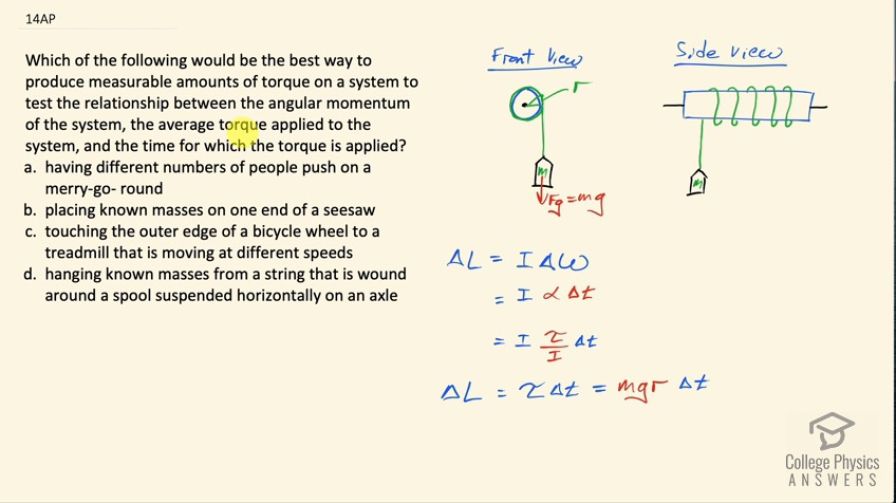Question
Which of the following would be the best way to produce measurable amounts of torque on a system to test the relationship between the angular momentum of the system, the average torque applied to the system, and the time for which the torque is applied?
- having different numbers of people push on a merry-go- round
- placing known masses on one end of a seesaw
- touching the outer edge of a bicycle wheel to a treadmill that is moving at different speeds
- hanging known masses from a string that is wound around a spool suspended horizontally on an axle
Final Answer
(d)
Solution video
OpenStax College Physics for AP® Courses, Chapter 10, Problem 14 (Test Prep for AP® Courses)

vote with a rating of
votes with an average rating of
.
Video Transcript
This is College Physics Answers with Shaun Dychko. We want to figure out what the best system is for testing the relationship between angular momentum, average torque applied and the time for which the torque is applied. So the answer is (d) here because we have a system that has a spool that's wound around with a string and a bunch of different known masses are hung from the string and this will cause a known amount of torque because we can measure the radius of the spool and we know that the weight is straight down and this torque is going to be this distance from the center multiplied by this weight, which is mass times gravitational field strength. Here's a side view: it shows that the string can be wound such that it's always going to be the same distance from the center of a spool even as it unwinds instead of having the string all piled up on top of each other in one position here, it's gonna be spread along the length of this spool. So change in angular momentum is moment of inertia times change in angular velocity and change in angular velocity is angular acceleration multiplied by time and this angular acceleration is the torque divided by moment of inertia, moment of inertia's cancel and we are left with change in angular momentum is the torque multiplied by time and the torque is the weight times the distance from the center of the spool times time and so with this, you could test many different masses and find how the change in angular momentum varies with mass and this setup is better than the other three options. For option (a), we have a different number of people pushing a merry-go-round we are not really sure how much torque each person is applying and different size people are very likely to apply different amounts of torque and even the same person could be changing their torque with time so it's not a very reliable way of doing things. (B) gives us a known amount of torque putting a mass at the end of a see-saw but there's not very much time like the see-saw will hit the ground really quickly and so with a small amount of time, you are gonna have a large error introduced because the percent error in the small amount of time will be large and for (c), touching the outer edge of a bicycle wheel to a treadmill, we are not really sure what the torque applied is... all we know is what the speed of the treadmill is. So (d) is the best answer to this question.